Flexible Glass: Myth and Photonic Technology
Abstract
1. Introduction
1.1. Flexible Glass in Egyptian and Roman Tales
1.2. Legend of Non-Breakable Glass in the Middle Age
2. Recent History of Flexible Glass
- −
- Asahi Glass Co. (AGC) (Tokyo, Japan): Innovated ultra-thin glass for next-generation displays, including foldable screens.
- −
- Central Glass Co., Ltd. (Tokyo, Japan): Specializes in ultra-thin glass for solar panels and electronics.
- −
- Corning Inc. (Corning, New York, NY, USA): Renowned for its Gorilla Glass, Corning has expanded into ultra-thin glass for foldable devices and flexible electronics applications.
- −
- Emerge Glass (New Delhi, India): A key player in the South Asian market, offering specialized ultra-thin glass products.
- −
- Luoyang Glass Co., Ltd. (Luoyang, China): Focuses on ultra-thin glass for various industrial applications.
- −
- Nippon Electric Glass Co., Ltd., NEG (Shiga, Japan): Produces ultra-thin glass for touchscreens and advanced display technologies.
- −
- Nippon Sheet Glass Co., Ltd., NSG (Tokyo, Japan): Produces ultra-thin UFF and Glanova glasses widely used in the automobile industry and in the liquid crystal industry.
- −
- Schott AG (Mainz, Germany): Offers products such as the ultra-thin Schott AS 87 Eco, designed for use in consumer electronics, particularly in smartphones and wearable devices.
- −
- Xinyi Glass Holdings (Hong Kong, China): Supplies ultra-thin glass for electronics and the solar energy industry.
3. Photonic Applications of Flexible Glasses
3.1. Flexible Solar Photovoltaic Systems
3.1.1. CdTe Solar Cells onto UTG Substrates
3.1.2. CIGS and Perovskite Solar Cells onto Flexible Glass Substrates
4. Conclusions
Author Contributions
Funding
Acknowledgments
Conflicts of Interest
References
- Peng, J.; Snyder, G.J. A figure of merit for flexibility. Science 2019, 366, 690–691. [Google Scholar] [CrossRef] [PubMed]
- Peng, J.; Grayson, M.; Snyder, G.J. What makes a material bendable? A thickness-dependent metric for bendability, malleability, ductility. Matter 2021, 4, 2694–2696. [Google Scholar] [CrossRef]
- Varshneya, A.K.; Macrelli, G.; Yoshida, S.; Kim, S.H.; Ogrinc, A.L.; Mauro, J.C. Indentation and abrasion in glass products: Lessons learned and yet to be learned. Int. J. Appl. Glass Sci. 2022, 13, 308–337. [Google Scholar] [CrossRef]
- Macrelli, G.; Varshneya, A.K.; Mauro, J.C. Ultra-thin glass as a substrate for flexible photonics. Opt. Mater. 2020, 106, 109994. [Google Scholar] [CrossRef]
- Righini, G.C.; Liñares, J. Active and Quantum Integrated Photonic Elements by Ion Exchange in Glass. Appl. Sci. 2021, 11, 5222. [Google Scholar] [CrossRef]
- Xue, L.; Wang, J.; Wang, J.; Ruan, H. Plastic deformation and recovery in ultrathin aluminosilicate glass. Extrem. Mechan Lett. 2024, 71, 102219. [Google Scholar] [CrossRef]
- Pliny the Elder, Natural History 36.LXVI.195. Available online: https://penelope.uchicago.edu/Thayer/L/Roman/Texts/Pliny_the_Elder/36*.html (accessed on 7 January 2025).
- Caius Petronius Arbiter, Satiricon Liber LI. Available online: https://www.thelatinlibrary.com/petronius1.html (accessed on 7 January 2025).
- Wallace-Dunlop, M.A. Glass in the Old World; Field & Tuer: London, UK, 1883. [Google Scholar]
- Gardiner, J.H. Rustless steel and flexible glass 5000 years ago? Nature 1926, 117, 791. [Google Scholar] [CrossRef]
- Lattermann, G. The Malleable Glass of the Ancients. E-Plastory 2017. N. 6. Available online: http://e-plastory.com/index.php/e-plastory/article/view/Lattermann (accessed on 14 January 2025).
- Lucchini, F. Aleardino’s glass. Art. Hist. 2013, 36, 498–517. [Google Scholar] [CrossRef]
- Righini, G.C.; Krzak, J.; Lukowiak, A.; Macrelli, G.; Varas, S.; Ferrari, M. From flexible electronics to flexible photonics: A brief overview. Opt. Mater. 2021, 115, 111011. [Google Scholar] [CrossRef]
- Koden, M. OLED Displays and Lighting; John Wiley & Sons: New York, NY, USA, 2016. [Google Scholar]
- Hong, G.; Gan, X.; Leonhardt, C.; Zhang, Z.; Seibert, J.; Busch, J.M.; Brase, S. A brief history of OLEDS—Emitter Developments and Industry Milestones. Adv. Mater. 2021, 33, 2005630. [Google Scholar] [CrossRef]
- OLED History: A ‘Guided Tour’ of OLED Highlights from Invention to Application. Available online: https://www.oled-info.com/history (accessed on 15 January 2025).
- Tiwari, R.K.; Mishra, R.; Sharma, S.K.; Prabhu, N.; Nagar, M.R.; Grigalevicius, S. Advancing Cancer Treatment and Diagnosis: A Review on Photodynamic Therapy Using OLED Technology. Molecules 2025, 30, 1305. [Google Scholar] [CrossRef] [PubMed]
- Yang, S.; Ren, Y.; Luo, D.; Shang, X.; Fang, W.; Ye, S.; Liu, B. Research progress in hybrid light-emitting diodes based on quantum dots and organic emitters. J. Lumin. 2024, 270, 120560. [Google Scholar] [CrossRef]
- Deva, L.; Stakhira, P.; Fitio, V.; Guminilovych, R.; Bulavinets, T.; Stanitska, M.; Volyniuk, D. Exploring quantum wells in oled technologies: A comprehensive review of applications and advancements. Ukr. J. Phys. Opt. 2025, 26, 02001–02047. [Google Scholar] [CrossRef]
- UFF™ and Glanova®—Thin Glass Manufacturing Technology and Material Development Capabilities. Available online: https://100th.nsg.com/story/12/ (accessed on 15 January 2025).
- Available online: https://hpm.nsg.com/en/products/uff/index.html (accessed on 15 January 2025).
- Auch, M.D.J.; Soo, O.K.; Ewald, G.; Soo-Jin, C. Ultrathin glass for flexible OLED application. Thin Solid Films 2002, 417, 47–50. [Google Scholar] [CrossRef]
- Guenther, E.; Kumar, R.S.; Zhu, F.; Low, H.Y.; Ong, K.S.; Auch, M.D.J.; Zhang, K.; Chua, S.-J. Building blocks for ultrathin flexible organic electroluminescent devices. In Organic Light-Emitting Materials and Devices V; Kafafi, Z.H., Ed.; SPIE: Bellingham, DC, USA, 2002; Volume 4464, pp. 23–33. [Google Scholar]
- Plichta, A.; Weber, A.; Habeck, A. Ultra Thin Flexible Glass Substrates. MRS Online Proc. Libr. 2003, 769, 91. [Google Scholar] [CrossRef]
- Ong, K.S.; Hu, J.; Shrestha, R.; Zhu, F.; Chua, S.J. Flexible polymer light emitting devices using polymer-reinforced ultrathin glass. Thin Solid Films 2005, 477, 32–37. [Google Scholar] [CrossRef]
- Gardiner, B. Glass Works: How Corning Created the Ultrathin, Ultrastrong Material of the Future. Wired, 24 September 2012. Available online: https://www.wired.com/2012/09/ff-corning-gorilla-glass/ (accessed on 23 January 2025).
- Available online: https://www.corning.com/gorillaglass/worldwide/en.html (accessed on 23 January 2025).
- Garner, S.M. (Ed.) Flexible Glass Enabling Thin, Lightweight, and Flexible Electronics; Wiley: Hoboken, NJ, USA, 2017. [Google Scholar]
- Available online: https://www.agc-yourglass.com/sites/default/files/agc_docs/Falcon_0420_EN.pdf (accessed on 30 January 2025).
- Available online: https://www.corning.com/microsites/csm/gorillaglass/PI_Sheets/2020/CorningGorillaGlass6_PISheet.pdf (accessed on 30 January 2025).
- Available online: https://www.corning.com/media/worldwide/Innovation/documents/WillowGlass/CorningWillowGlassFactSheets_August2019.pdf (accessed on 30 January 2025).
- Available online: https://www.neg.co.jp/en/assets/file/product/dp/en-g-leaf.pdf (accessed on 7 February 2025).
- Available online: https://hpm.nsg.com/en/products/glanova/index.html (accessed on 7 February 2025).
- Available online: https://www.schott.com/en-gb/products/as-87-neo-p1000312/technical-details (accessed on 7 February 2025).
- Available online: https://www.schott.com/en-gb/products/d-263-p1000318/technical-details (accessed on 7 February 2025).
- Hu, J.J.; Li, L.; Lin, H.; Zhang, P.; Zhou, W.; Ma, Z. Flexible integrated photonics: Where materials, mechanics and optics meet. Opt. Mater. Express 2013, 3, 1313–1331. [Google Scholar] [CrossRef]
- Li, H.; Cao, Y.; Wang, Z.; Feng, X. Flexible and stretchable inorganic optoelectronics. Opt. Mater. Express 2019, 9, 4023–4049. [Google Scholar] [CrossRef]
- Ma, Z.; Liu, D. (Eds.) Inorganic Flexible Optoelectronics; Wiley: Weinheim, Germany, 2019. [Google Scholar]
- Ray, K.A. Flexible Solar Cell Arrays for Increased Space Power. IEEE Trans. AES 1967, AES-3, 107–115. [Google Scholar] [CrossRef]
- Gupta, R.K.; Ngujen, T.A. (Eds.) Smart and Flexible Energy Devices; CRC Press: Boca Raton, FL, USA, 2022. [Google Scholar]
- Cairns, D.R.; Broer, D.J.; Crawford, G.P. (Eds.) Flexible Flat Panel Displays, 2nd ed.; Wiley: Weinheim, Germany, 2023. [Google Scholar]
- Zhao, Z.; Liu, K.; Liu, Y.; Guo, Y.; Liu, Y. Intrinsically flexible displays: Key materials and devices. Nat. Sci. Rev. 2022, 9, nwac090. [Google Scholar] [CrossRef]
- Kong, B.; Lee, J.-y.; Jo, H.-h.; Chowdhury, D. Ultrathin Glass Processing Technologies for Bendable OLED Taillight: Innovative Ultrathin Glass Solutions for OLED Lighting Application. IEEE Electron Dev. Mag. 2024, 2, 44–50. [Google Scholar] [CrossRef]
- Li, L.; Lin, H.; Michon, J.; Geiger, S.; Li, J.; Zheng, H.; Huang, Y.; Yadav, A.; Richardson, K.A.; Gu, T.; et al. Mechanically Flexible Integrated Photonic Systems for Sensing and Communications. ECS Trans. 2017, 77, 37. [Google Scholar] [CrossRef]
- Sayginer, O.; Iacob, E.; Varas, S.; Szczurek, A.; Ferrari, M.; Lukowiak, A.; Righini, G.C.; Bursi, O.S.; Chiasera, A. Design, fabrication and assessment of an optomechanical sensor for pressure and vibration detection using flexible glass multilayers. Opt. Mater. 2021, 115, 111023. [Google Scholar] [CrossRef]
- Zuo, H.; Yu, S.; Hu, J.J. Low loss, flexible single-mode polymer photonics. Opt. Express 2019, 27, 11152–11159. [Google Scholar] [CrossRef] [PubMed]
- Serpe, M.J.; Kang, Y.; Zhang, Q.M. (Eds.) Photonic Materials for Sensing, Biosensing and Display Devices; Springer International Publishing: Cham, Switzerland, 2016. [Google Scholar]
- Takei, K. (Ed.) Flexible and Stretchable Medical Devices; Wiley: Weinheim, Germany, 2018. [Google Scholar]
- Zhang, C.; Zhao, Y.S. Flexible Photonic Materials and Devices: Synthetic Strategies, Sensing Properties, and Wearable Applications. Adv. Mater. 2024, 2415856, e2415856. [Google Scholar] [CrossRef] [PubMed]
- Knauer, K.A.; Najafabadi, E.; Haske, W.; Gaj, M.P.; Davis, K.C.; Fuentes-Hernandez, C.; Carrasco, U.; Kippelen, B. Stacked inverted top-emitting green electrophosphorescent organic light-emitting diodes on glass and flexible glass substrates. Org. Electron. 2013, 14, 2418–2423. [Google Scholar] [CrossRef]
- Burch, J.; Wen, D.; Chen, X.; Di Falco, A. Conformable Holographic Metasurfaces. Sci. Rep. 2017, 7, 4520. [Google Scholar] [CrossRef]
- Li, L.; Lin, H.; Michon, J.; Huang, Y.; Li, J.; Du, Q.; Yadav, A.; Richardson, K.; Gu, T.; Hu, J.J. A new twist on glass: A brittle material enabling flexible integrated photonics. Int. J. Appl. Glass Sci. 2017, 8, 61–68. [Google Scholar] [CrossRef]
- Sun, H.; Li, X. Recent Advances on III-Nitride Nanowire Light Emitters on Foreign Substrates—Toward Flexible Photonics. Phys. Status Solidi A 2019, 216, 1800420. [Google Scholar] [CrossRef]
- Sharma, G.; Kattayat, S.; Naqvi, S.F.; Hashm, S.Z.; Alvi, P.A. Role of MEH:PPV polymer in single layer OLEDs with its optoelectronic characteristics. Mater. Today Proc. 2021, 42, 1678–1681. [Google Scholar] [CrossRef]
- Peng, C.; Su, H.; Li, J.; Duan, Q.; Li, Q.; Xiao, J.; Ku, Z.; Zhong, J.; Li, W.; Peng, Y.; et al. Scalable, efficient and flexible perovskite solar cells with carbon film based electrode. Sol. Energy Mater. Sol. Cells 2021, 230, 111226. [Google Scholar] [CrossRef]
- Holmes, C.; Dulieu-Barton, J. Flexible Photonics in Carbon and Glass Fiber Reinforced Polymers for New Multifunctionality: Exploring the Advances, Challenges, and Opportunities. Opt. Mater. X 2023, 20, 100277. [Google Scholar] [CrossRef]
- Wang, Y.; Yuan, S.; Wang, G.; Fan, Z.; Zhang, J.; Li, Z.; Liu, C.; Zhao, D.; Chai, Z.; Lu, X. Flexible, transparent and conductive silver line electrodes fabricated using surface energy-directed assembly process on polyethylene naphthalate substrates. Chem. Eng. J. 2025, 509, 161172. [Google Scholar] [CrossRef]
- Zhang, S.; Ao, J.; Ding, L.; Chen, Y.; Xu, J.; Sun, Z.; Li, Y.; Wu, L.; Liu, X.; Jiang, S. Flexible, robust and reusable Ag nanoparticle-coated polyamide SERS substrates for rapid identification of toxic substances on curved surfaces. Microchem. J. 2025, 209, 112899. [Google Scholar] [CrossRef]
- Enrichi, F.; Righini, G.C. (Eds.) Solar Cells and Light Management; Elsevier: Amsterdam, The Netherlands, 2020. [Google Scholar]
- Ibn-Mohammed, T.; Koh, S.C.L.; Reaney, I.M.; Acquaye, A.; Schileo, G.; Mustapha, K.B.; Greenough, R. Perovskite solar cells: An integrated hybrid lifecycle assessment and review in comparison with other photovoltaic technologies. Renew. Sust. Energy Rev. 2017, 80, 1321–1344. [Google Scholar] [CrossRef]
- Brown, C.R.; Eperon, G.E.; Whiteside, V.R.; Sellers, I.R. Potential of High-Stability Perovskite Solar Cells for Low-Intensity–Low-Temperature (LILT) Outer Planetary Space Missions. ACS Appl. Energy Mater. 2019, 2, 814–821. [Google Scholar] [CrossRef]
- Li, J.; Aierken, A.; Liu, Y.; Zhuang, Y.; Yang, X.; Mo, J.H.; Fan, R.K.; Chen, Q.Y.; Zhang, S.Y.; Huang, Y.M.; et al. A Brief Review of High Efficiency III-V Solar Cells for Space Application. Front. Phys. 2021, 8, 631925. [Google Scholar] [CrossRef]
- Verduci, R.; Romano, V.; Brunetti, G.; Nia, N.Y.; Di Carlo, A.; D’Angelo, G.; Ciminelli, C. Solar Energy in Space Applications: Review and Technology Perspectives. Adv. Energy Mater. 2022, 12, 2200125. [Google Scholar] [CrossRef]
- Pessoa, R.S.; Amorim Fraga, M. Recent Advances in Solar Cells for Aerospace Applications: Materials and Technologies. J. Aerosp. Technol. Manag. 2023, 15, 1296. [Google Scholar] [CrossRef]
- Angmo, D.; Yan, S.; Liang, D.; Scully, A.D.; Chesman, A.S.R.; Kellam, M.; Duffy, N.W.; Carter, N.; Chantler, R.; Chen, C.; et al. Toward Rollable Printed Perovskite Solar Cells for Deployment in Low-Earth Orbit Space Applications. ACS Appl. Energy Mater. 2024, 7, 1777–1791. [Google Scholar] [CrossRef]
- Li, Y.; Kamaraj, K.; Silori, Y.; Zhao, H.; Arneson, C.; Liu, B.; Ogilvie, J.; Forrest, S.R. Radiation hardness of organic photovoltaics. Joule 2025, 9, 101800. [Google Scholar] [CrossRef]
- Kaltenbrunner, M.; Adam, G.; Głowacki, E.D.; Drack, M.; Schwödiauer, R.; Leonat, L.; Apaydin, D.H.; Groiss, H.; Scharber, M.C.; White, M.S.; et al. Flexible high power-per-weight perovskite solar cells with chromium oxide–metal contacts for improved stability in air. Nat. Mater. 2015, 14, 1032–1039. [Google Scholar] [CrossRef] [PubMed]
- Ahmad, N.I.; Kar, Y.B.; Doroody, C.; Kiong, T.S.; Rahman, K.S.; Harif, M.N.; Amin, N. A comprehensive review of flexible cadmium telluride solar cells with back surface field layer. Heliyon 2023, 9, e21622. [Google Scholar] [CrossRef]
- Available online: https://omnexus.specialchem.com/selection-guide/polyethylene-terephthalate-pet-plastic (accessed on 2 April 2025).
- Gorter, T.; Reinders, A.H.M.E. A comparison of 15 polymers for application in photovoltaic modules in PV-powered boats. Appl. Energy 2012, 92, 286–297. [Google Scholar] [CrossRef]
- Miranda, I.; Souza, A.; Sousa, P.; Ribeiro, J.; Castanheira, E.M.S.; Lima, R.; Minas, G. Properties and Applications of PDMS for Biomedical Engineering: A Review. J. Funct. Biomater. 2021, 13, 2. [Google Scholar] [CrossRef]
- Haynes, G.A. Effect of Radiation on Cerium-Doped Solar-Cell Cover Glass. NASA Techn. Note 1970, TN D-6024. Available online: https://ntrs.nasa.gov/api/citations/19710002803/downloads/19710002803.pdf (accessed on 14 February 2025).
- Yang, G.; Cho, E.W.; Hwang, Y.J.; Min, B.K.; Kang, Y.; Kim, D.; Kim, J. Radiation-Hard and Ultralightweight Polycrystalline Cadmium Telluride Thin-Film Solar Cells for Space Applications. Energy Technol. 2016, 4, 1463. [Google Scholar] [CrossRef]
- Lamb, D.A.; Underwood, C.I.; Barrioz, V.; Gwilliam, S.; Hall, J.; Baker, M.A.; Irvine, S.J.C. Proton irradiation of CdTe thin film photovoltaics deposited on cerium-doped space glass. Prog. Photovolt. Res. Appl. 2017, 25, 1059–1067. [Google Scholar] [CrossRef]
- Available online: https://www.excelitas.com/file-download/download/public/58456?filename=Qioptiq_Space-Qualified_Cover_Glass_Datasheet.pdf (accessed on 6 February 2025).
- Lamb, D.A.; Irvine, S.J.C.; Baker, M.A.; Underwood, C.; Mardhani, S. Thin film cadmium telluride solar cells on ultra-thin glass in low earth orbit–3 years of performance data on the AlSat-1N CubeSat mission. Prog. Photovolt. 2021, 29, 1000–1007. [Google Scholar] [CrossRef]
- Bonnet, D.; Henrichs, B.; Richter, H. High-rate deposition of high-quality CdTe films for high-efficiency solar cells. In Proceedings of the The Conference Record of the Twenty-Second IEEE Photovoltaic Specialists Conference, Las Vegas, NV, USA, 7–11 October 1991; Volume 2, pp. 1165–1168. [Google Scholar] [CrossRef]
- Romeo, A.; Artegiani, E. CdTe-Based Thin Film Solar Cells: Past, Present and Future. Energies 2021, 14, 1684. [Google Scholar] [CrossRef]
- Teloeken, A.; Lamb, D.; Dunlop, T.; Irvine, S. Effect of bending test on the performance of CdTe solar cells on flexible ultra-thin glass produced by MOCVD. Sol. Energy Mater. Sol. Cells 2020, 211, 110552. [Google Scholar] [CrossRef]
- Rance, W.L.; Burst, J.M.; Meysing, D.M.; Wolden, C.A.; Reese, M.O.; Gessert, T.A.; Metzger, W.K.; Garner, S.; Cimo, P.; Barnes, T.M. 14%-efficient flexible CdTe solar cells on ultra-thin glass substrates. Appl. Phys. Lett. 2014, 104, 827. [Google Scholar] [CrossRef]
- Mahabaduge, H.P.; Rance, W.L.; Burst, J.M.; Reese, M.O.; Meysing, D.M.; Wolden, C.A.; Li, J.; Beach, D.; Gessert, T.A.; Metzger, W.K.; et al. High-efficiency, flexible CdTe solar cells on ultra-thin glass substrates. Appl. Phys. Lett. 2015, 106, 133501. [Google Scholar] [CrossRef]
- Liyanage, G.K.; Grice, C.R.; Phillips, A.B.; Song, Z.; Watthage, S.C.; Franzer, N.D.; Garner, S.; Yan, Y.; Heben, M.J. RF-sputtered Cd2SnO4 for flexible glass CdTe solar cells. In Proceedings of the IEEE 43rd Photovoltaic Specialists Conference (PVSC), Portland, OR, USA, 5–10 June 2016; pp. 0450–0453. [Google Scholar] [CrossRef]
- Doroody, C.; Rahman, K.; Abdullah, S.; Harif, M.; Rosly, H.; Tiong, S.; Amin, N. Temperature difference in close-spaced sublimation (CSS) growth of CdTe thin film on ultra-thin glass substrate. Results Phys. 2020, 18, 103213. [Google Scholar] [CrossRef]
- Amin, N.; Karim, M.R.; ALOthman, Z.A. An In-Depth Analysis of CdTe Thin-Film Deposition on Ultra-Thin Glass Substrates via Close-Spaced Sublimation (CSS). Coatings 2022, 12, 589. [Google Scholar] [CrossRef]
- Jamarkattel, M.K.; Abbas, A.; Mathew, X.; Neupane, S.; Bastola, E.; Li, D.B.; Seibert, S.; Patel, A.P.; Song, Z.; Liu, X.; et al. 17.2% Efficient CdSexTe1− x solar cell with (InxGa1−x)2O3 emitter on lightweight and flexible glass. Appl. Phys. Lett. 2024, 124, 080601. [Google Scholar] [CrossRef]
- Huang, K.; Wu, Q.; Liu, X. Picosecond pulsed laser scribing of Cd2SnO4-based CdTe thin-film solar cells on flexible glass. Sol. Energy 2024, 283, 112999. [Google Scholar] [CrossRef]
- Keller, J.; Kiselman, K.; Donzel-Gargand, O.; Martin, N.M.; Babucci, M.; Lundberg, O.; Wallin, E.; Stolt, L.; Edoff, M. High-concentration silver alloying and steep back-contact gallium grading enabling copper indium gallium selenide solar cell with 23.6% efficiency. Nat. Energy 2024, 9, 467–478. [Google Scholar] [CrossRef]
- Friedlmeier, T.M.; Jackson, P.; Bauer, A.; Hariskos, D.; Kiowski, O.; Wuerz, R.; Powalla, M. Improved Photocurrent in Cu(In,Ga)Se2 Solar Cells: From 20.8% to 21.7% Efficiency with CdS Buffer and 21.0% Cd-Free. IEEE J. Photovolt. 2015, 5, 1487–1491. [Google Scholar] [CrossRef]
- Dursch, H.W. CdS/CuInSe2 Solar Cells with Ti foil Substrate. U.S. Patent 4,703,131, 27 October 1987. [Google Scholar]
- Başol, B.M.; Kapur, V.K.; Halani, A.; Leidholm, C. Copper indium diselenide thin film solar cells fabricated on flexible foil substrates. Sol. En. Mater. Sol. Cells 1993, 29, 163–173. [Google Scholar] [CrossRef]
- Ishizuka, S.; Yamada, A.; Matsubara, K.; Fons, P.; Sakurai, K.; Niki, S. Development of high-efficiency Cu(InGa)Se2 solar cells: A study of alkali doping effect on CIS, CIGS and CGS using alkali-silicate glass thin layers. Curr. Appl. Phys. 2010, 10, S154–S156. [Google Scholar] [CrossRef]
- Badgujar, A.C.; Madhuri, K.; Garner, S.; Dhage, S.R.; Joshi, S.V. Non-vacuum route for CIGS thin film absorber on flexible glass substrates. In Proceedings of the IEEE 42nd Photovoltaic Specialist Conference (PVSC), New Orleans, LA, USA, 14–19 June 2015; pp. 1–4. [Google Scholar] [CrossRef]
- Gerthoffer, A.; Roux, F.; Emieux, F.; Faucherand, P.; Fournier, H.; Grenet, L.; Perraud, S. CIGS solar cells on flexible ultra-thin substrates: Characterization and bending test. Thin Solid Films 2015, 592, 99–104. [Google Scholar] [CrossRef]
- Gerthoffer, A.; Poulain, C.; Roux, F.; Emieux, F.; Grenet, L.; Perraud, S. CIGS solar cells on ultra-thin glass substrates: Determination of mechanical properties by nanoindentation and application to bending-induced strain calculation. Sol. Energy Mater. Sol. Cells. 2017, 166, 254–261. [Google Scholar] [CrossRef]
- Chen, J.; Shen, H.; Zhai, Z.; Liu, F.; Zhu, Z.; Luo, M. Performance and stability enhancement of Cu(InGa)Se2 solar cells on ultrathin glass by potassium incorporation. Mater. Lett. 2020, 271, 127749. [Google Scholar] [CrossRef]
- Kim, D.; Shin, S.S.; Lee, S.M.; Cho, J.S.; Yun, J.H.; Lee, H.S.; Park, J.H. Flexible and semi-transparent ultra-thin CIGSe solar cells prepared on ultra-thin glass substrate: A key to flexible bifacial photovoltaic applications. Adv. Funct. Mater. 2020, 30, 2001775. [Google Scholar] [CrossRef]
- Amare, A.M.; Hwang, I.; Jeong, I.; Park, J.H.; An, J.G.; Song, S.; Eo, Y.-J.; Cho, A.; Cho, J.-S.; Ahn, S.K.; et al. High-Efficiency Cadmium-Free Cu(In,Ga)Se2 Flexible Thin-Film Solar Cells on Ultra-Thin Glass as a Novel Substrate. J. Alloys Compd. 2025, 1024, 180187. [Google Scholar] [CrossRef]
- Hamtaei, S.; Debot, A.; Scaffidi, R.; Brammertz, G.; Cariou, E.; Garner, S.M.; Aguirre, A.; Poortman, J.; Dale, P.J.; Vermang, B. Fabrication of bendable and narrow bandgap Cu (In, Ga)(S, Se)2 for tandem photovoltaics. Commun. Mater. 2025, 6, 2. [Google Scholar] [CrossRef]
- Nia, N.Y.; Saranin, D.; Palma, A.L.; Di Carlo, A. Perovskite solar cell. In Solar Cells and Light Management; Enrichi, F., Righini, G.C., Eds.; Elsevier: Amsterdam, The Netherlands, 2020; pp. 163–228. [Google Scholar] [CrossRef]
- Harito, C.; Abrori, S.A.; Khalil, M.; Yuliarto, B.; Erten-Ela, S. Current progress of perovskite solar cells stability with bibliometric study. Curr. Opin. Colloid Interface Sci. 2024, 74, 101862. [Google Scholar] [CrossRef]
- Huang, S.; Qian, C.; Liu, X.; Zhang, L.; Meng, F.; Yan, Z.; Zhou, Y.; Du, J.; Ding, B.; Shi, J.; et al. A review on flexible solar cells. Sci. China Mater. 2024, 67, 2717–2736. [Google Scholar] [CrossRef]
- Aftab, S.; Hussain, S.; Kabir, F.; Aslam, M.; Rajpar, A.H.; Al-Sehemi, A.G. Advances in flexible perovskite solar cells: A comprehensive review. Nano Energy 2024, 120, 109112. [Google Scholar] [CrossRef]
- Tavakoli, M.M.; Tsui, K.-H.; Zhang, Q.; He, J.; Yao, Y.; Li, D.; Fan, Z. Highly Efficient Flexible Perovskite Solar Cells with Antireflection and Self-Cleaning Nanostructures. ACS Nano 2015, 9, 10287–10295. [Google Scholar] [CrossRef]
- Kim, W.; Cheng, J.; Choi, J.; Lee, S.; Lee, D.; Ko, M.J. Ultrathin Glass-Based Perovskite Solar Cells Employing Bilayer Electron Transport Layer. Korean J. Chem. Eng. 2024, 41, 3791–3798. [Google Scholar] [CrossRef]
- Ballipinar, F.; Rastogi, A.C.; Garner, S.M.; Darling, S.B. Planar mixed halide perovskite-PCBM solar cells on flexible glass substrates processed at low temperature without ITO. In Proceedings of the IEEE 43rd Photovoltaic Specialists Conference (PVSC), Portland, OR, USA, 5–10 June 2016; pp. 1611–1616. [Google Scholar] [CrossRef]
- Dou, B.; Miller, E.M.; Christians, J.A.; Sanehira, E.M.; Klein, T.R.; Barnes, F.S.; Shaheen, S.E.; Garner, S.M.; Ghosh, S.; Mallick, A.; et al. High-Performance Flexible Perovskite Solar Cells on Ultrathin Glass: Implications of the TCO. J. Phys. Chem. Lett. 2017, 8, 4960–4966. [Google Scholar] [CrossRef] [PubMed]
- Dai, X.; Deng, Y.; Van Brackle, C.H.; Chen, S.; Rudd, P.N.; Xiao, X.; Lin, Y.; Chen, B.; Huang, J. Scalable Fabrication of Efficient Perovskite Solar Modules on Flexible Glass Substrates. Adv. Energy Mater. 2019, 10, 1903108. [Google Scholar] [CrossRef]
- Castro-Hermosa, S.; Lucarelli, G.; Top, M.; Fahland, M.; Fahlteich, J.; Brown, T.M. Perovskite photovoltaics on roll-to-roll coated ultra-thin glass as flexible high-efficiency indoor power generators. Cell Rep. Phys. Sci. 2020, 1, 100045. [Google Scholar] [CrossRef]
- Tang, G.; Yan, F. Recent progress of flexible perovskite solar cells. Nano Today 2021, 39, 101155. [Google Scholar] [CrossRef]
- Goje, A.A.; Ludin, N.A.; Fahsyar, P.N.A.; Syafiq, U.; Chelvanathan, P.; Syakirin, A.D.A.-G.; Teridi, M.A.; Ibrahim, M.A.; Su’ait, M.S.; Sepeai, S.; et al. Review of flexible perovskite solar cells for indoor and outdoor applications. Ren. Sustain. Energy 2024, 13, 155–179. [Google Scholar] [CrossRef]
- Tian, R.; Zhou, S.; Meng, Y.; Liu, C.; Ge, Z. Material and device design of flexible perovskite solar cells for next-generation power supplies. Adv. Mater. 2024, 36, 202311473. [Google Scholar] [CrossRef]
- Keller, V. Storied Objects, Scientific Objects, and Renaissance Experiment: The Case of Malleable Glass. Renaiss. Q. 2017, 70, 594–632. [Google Scholar] [CrossRef]
- Moss, D. 2D Graphene Oxide Films for Electronic and Photonic Integrated Chips. 2023, hal-04171932. Preprint Submitted on 27 July 2023. Available online: https://hal.science/hal-04171932v1 (accessed on 14 February 2025).
- Wu, J.; Zhang, Y.; Hu, J.; Yang, Y.; Jin, D.; Liu, W.; Huang, D.; Jia, B.; Moss, D.J. 2D Graphene Oxide Films Expand Functionality of Photonic Chips. Adv. Mater. 2024, 36, 2403659. [Google Scholar] [CrossRef]
- Wei, N.; Li, Q.; Cong, S.; Ci, H.; Song, Y.; Yang, O.; Lu, C.; Li, C.; Zou, G.; Sun, J.; et al. Direct synthesis of flexible graphene glass with macroscopic uniformity enabled by copper-foam-assisted PECVD. J. Mater. Chem. A 2019, 7, 4813–4822. [Google Scholar] [CrossRef]
- Miao, R.-X.; Zhao, C.-H.; Wang, S.-Q.; Ren, W.; Li, Y.-F.; Shu, T.-K.; Yang, B. Direct growth of graphene films without catalyst on flexible glass substrates by PECVD. Chin. Phys. B 2021, 30, 098101. [Google Scholar] [CrossRef]


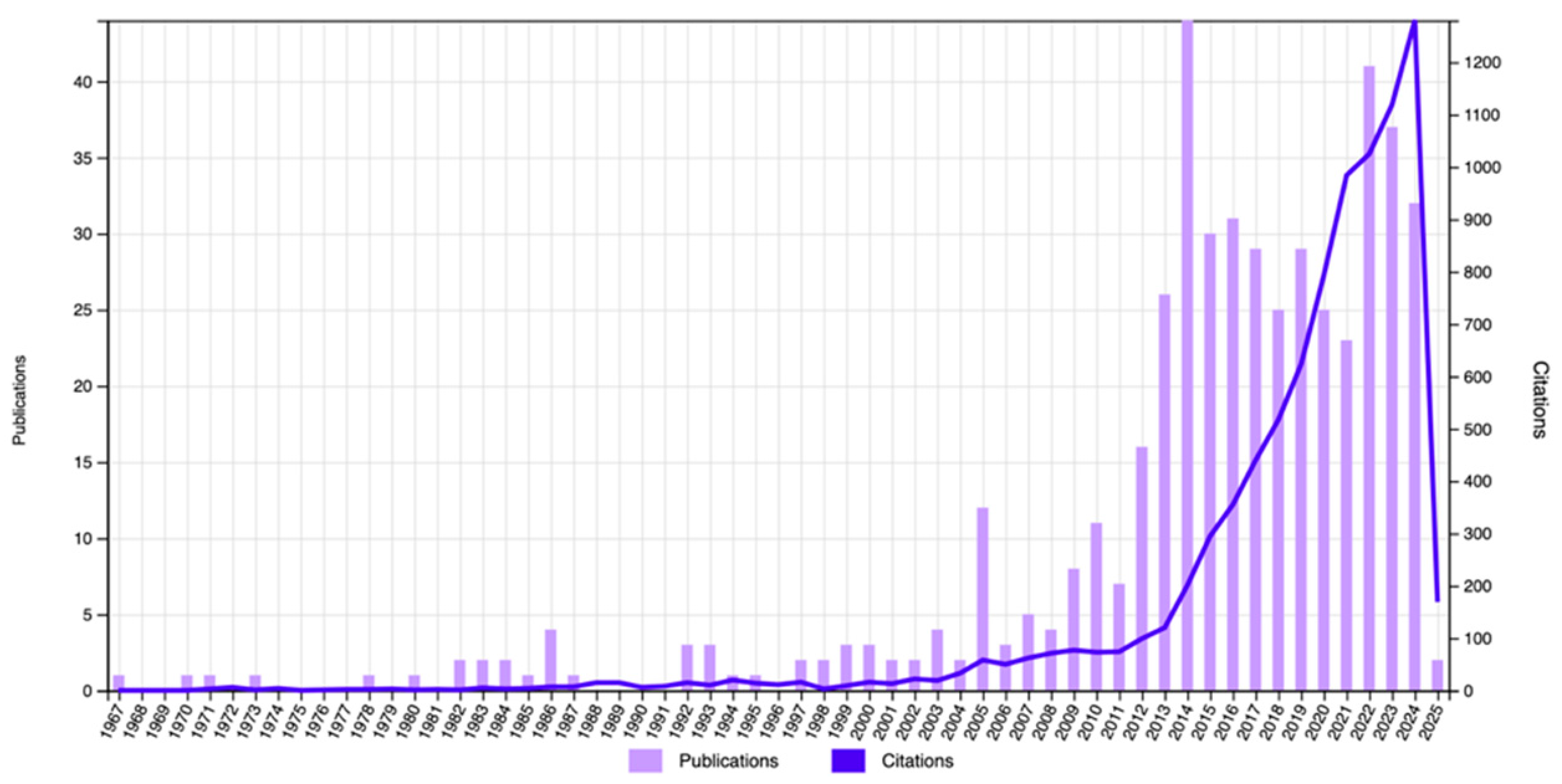
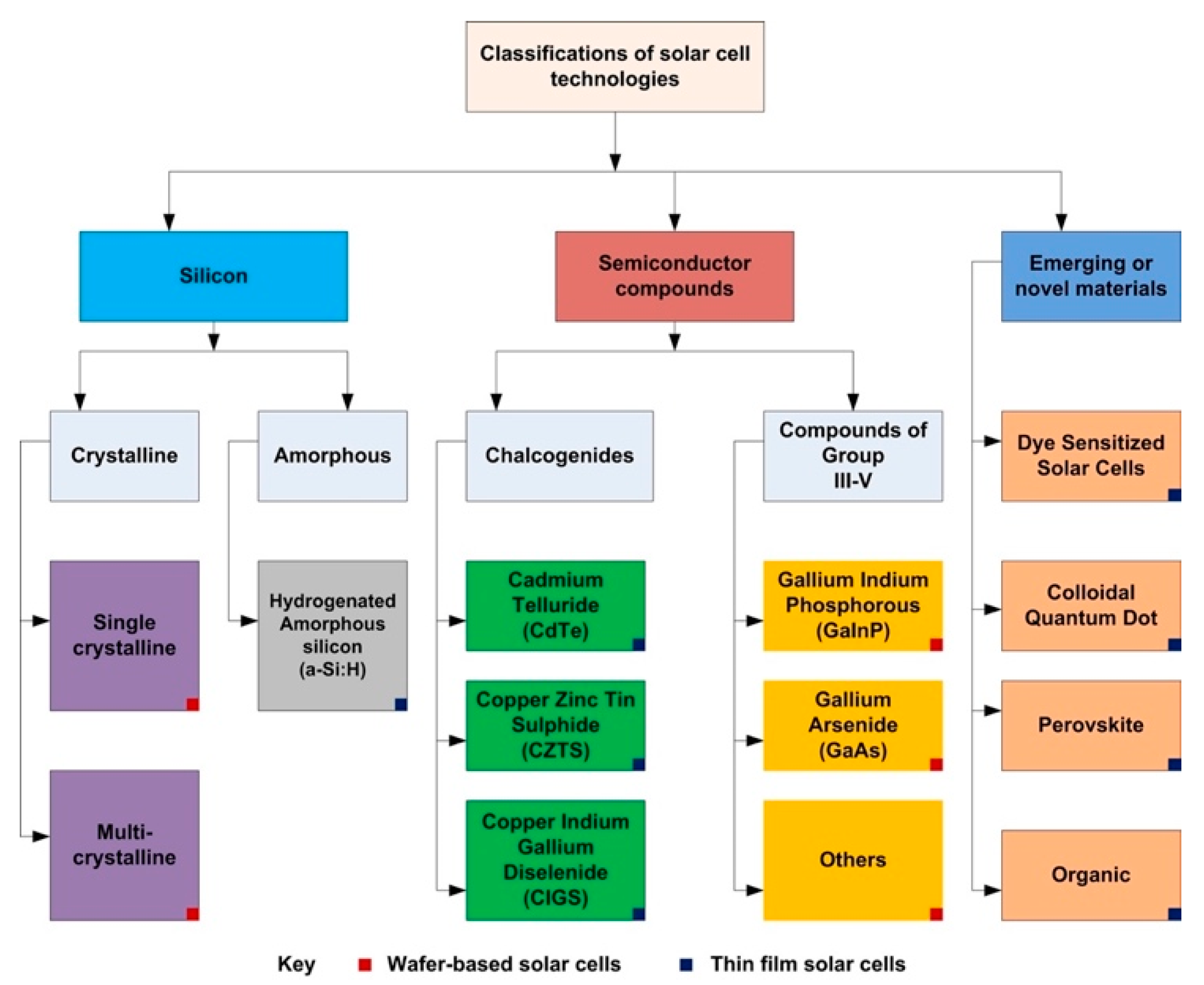
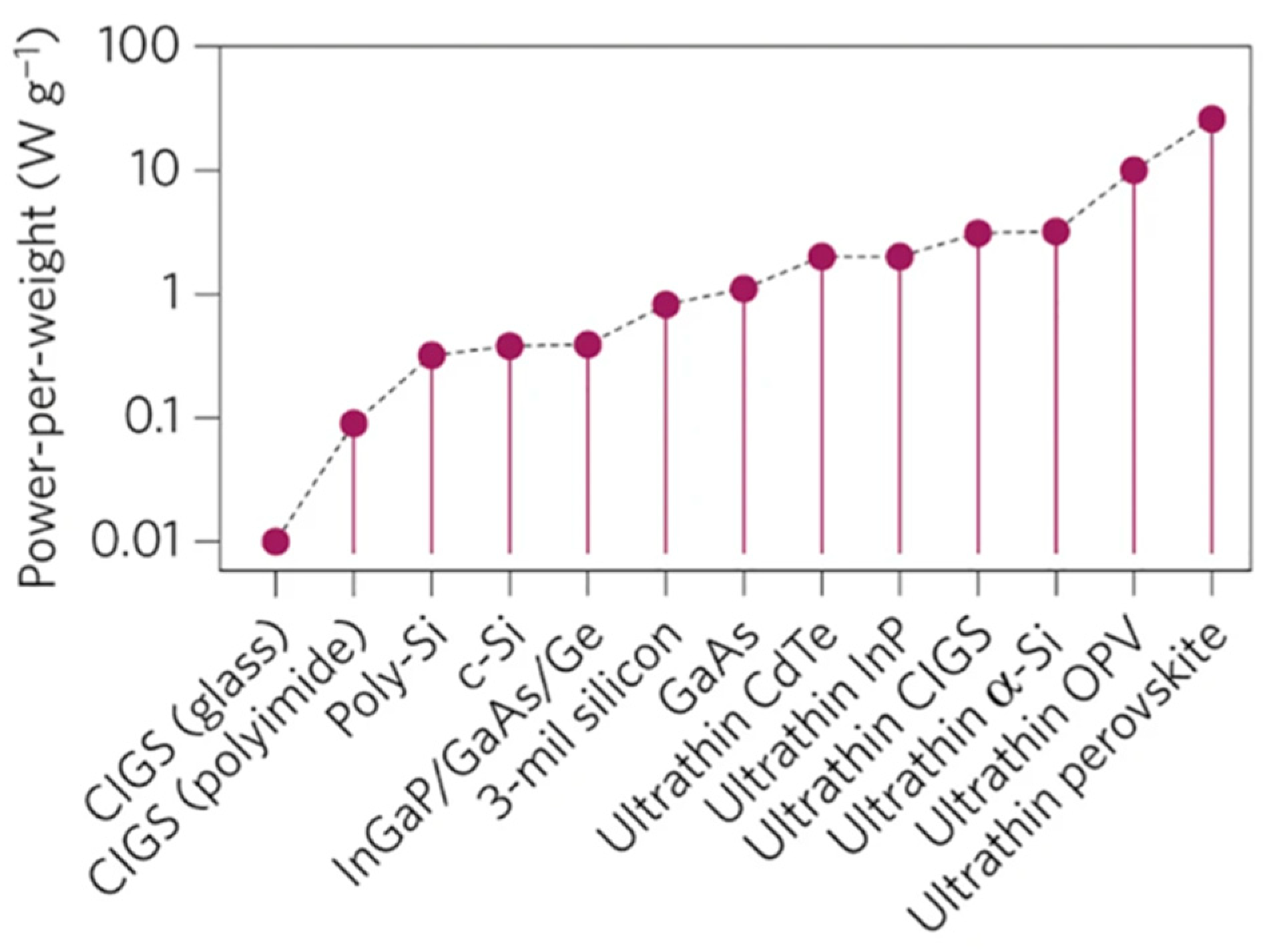
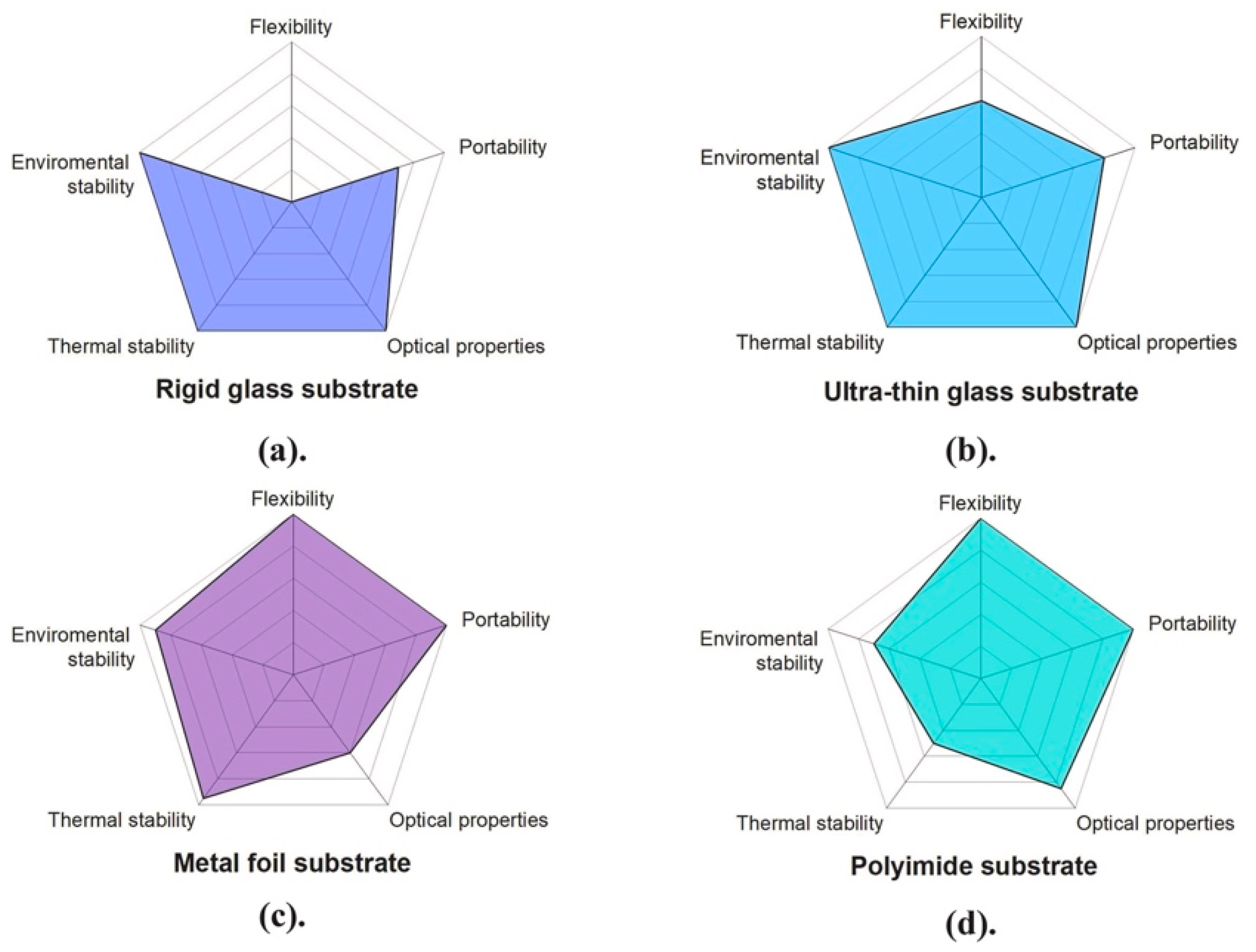
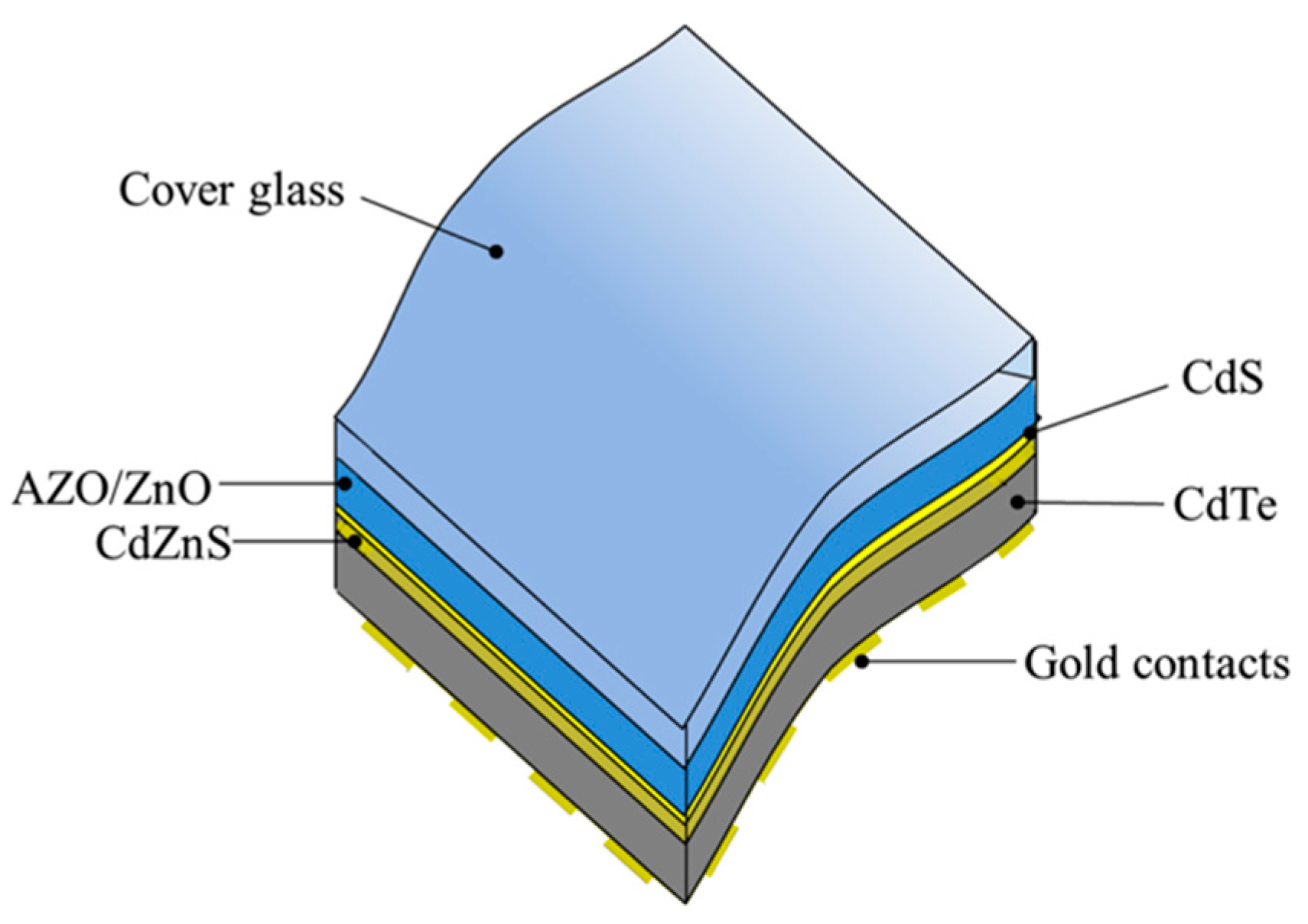
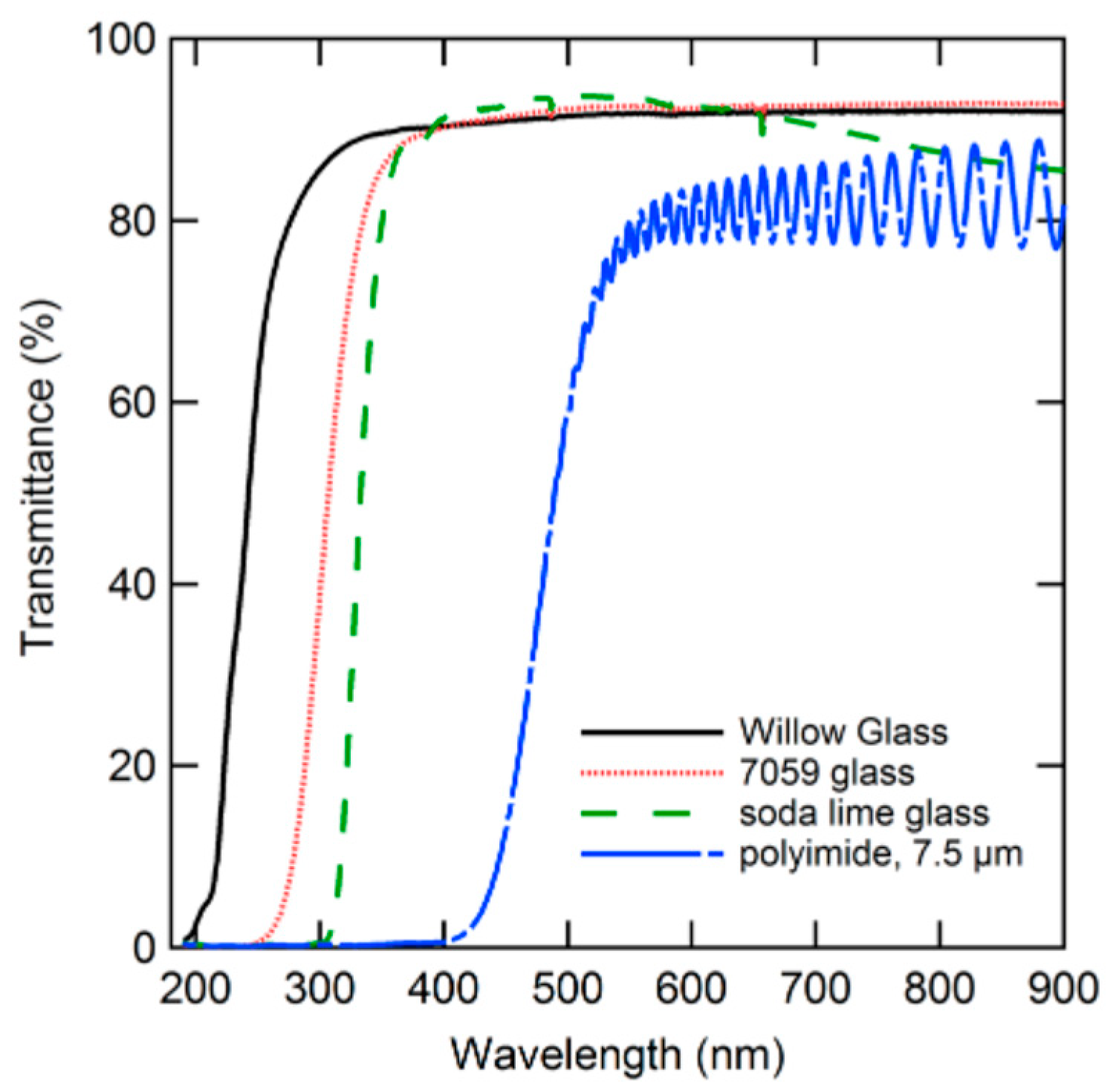

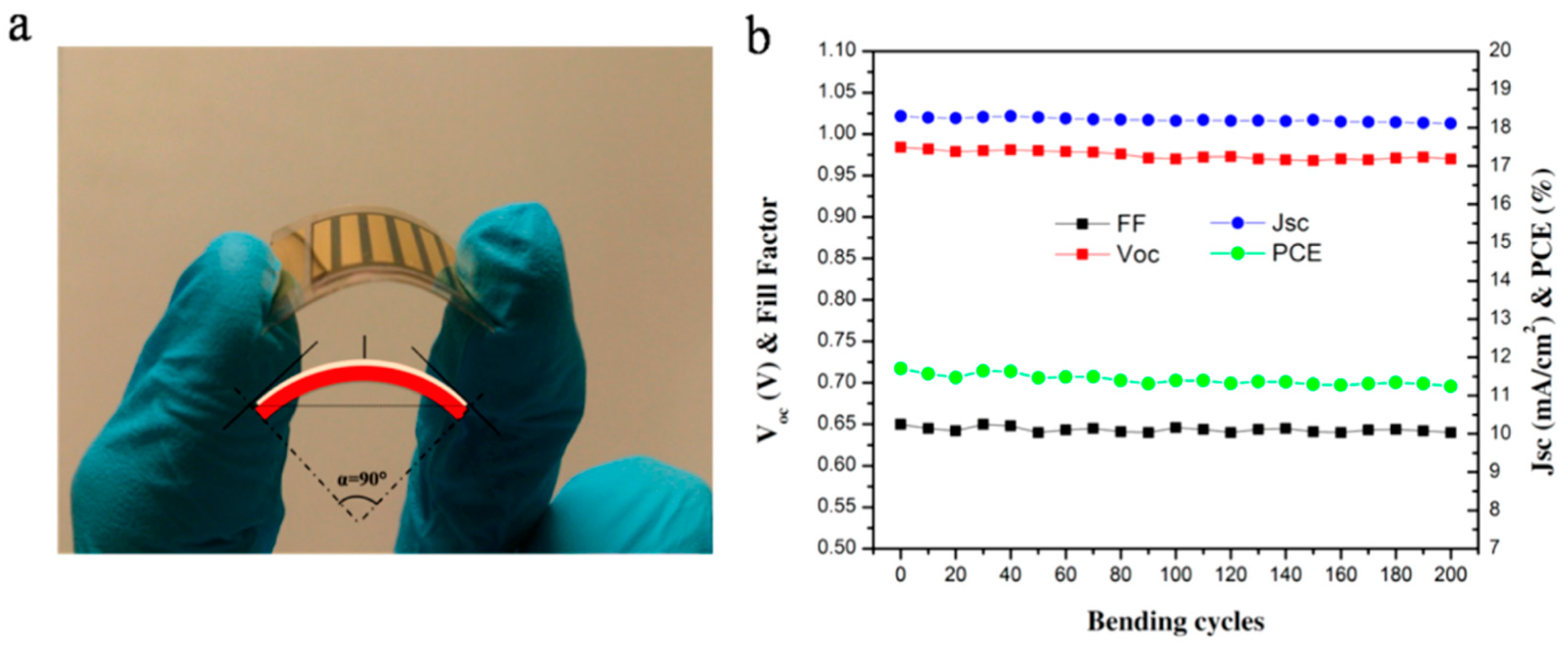
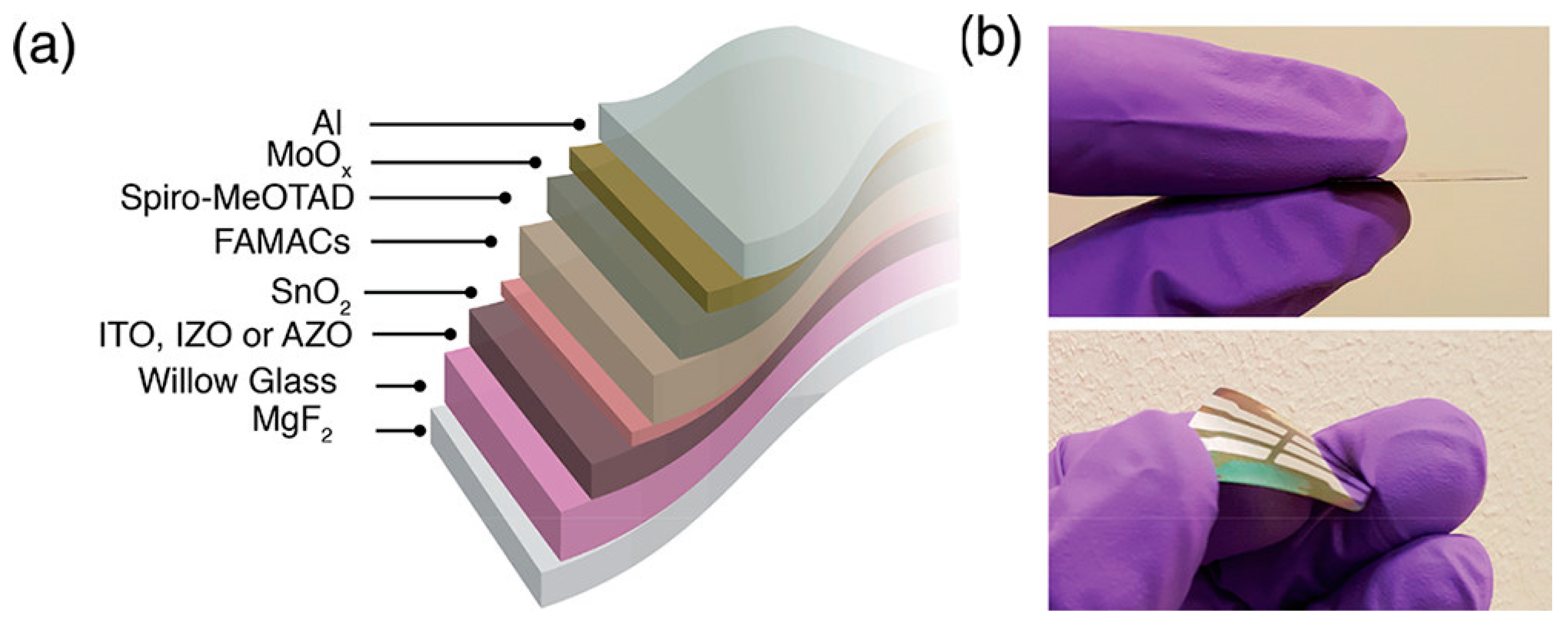
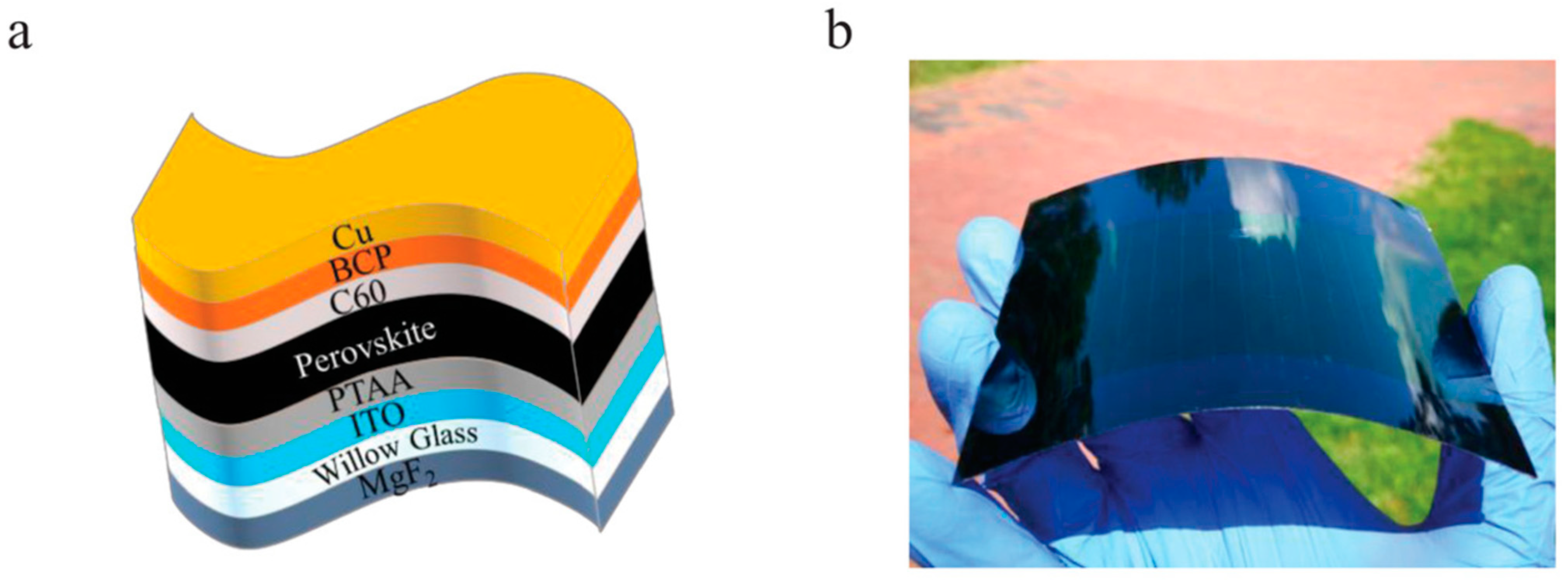
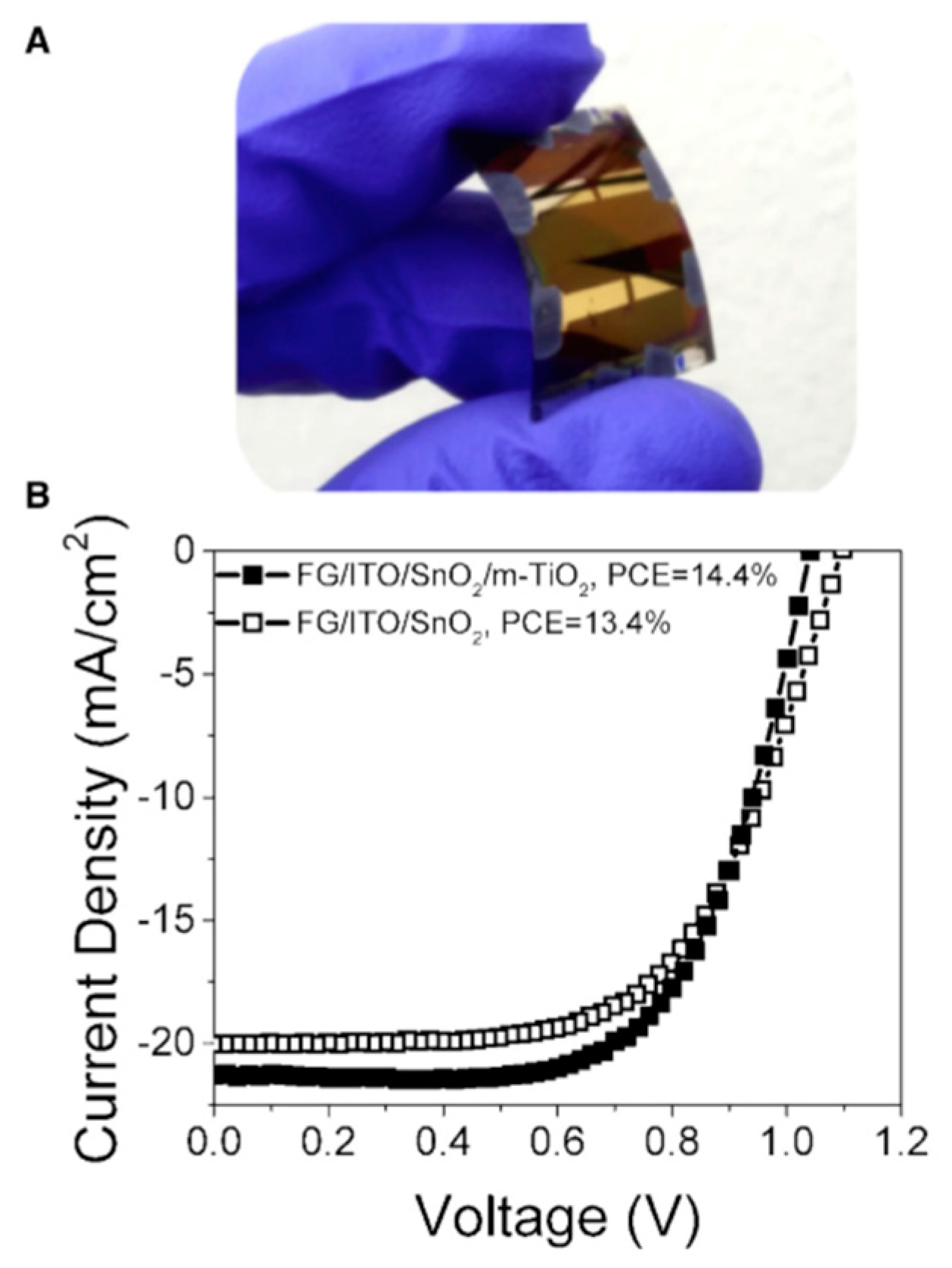
| Brand Name | Unit | AGC Falcon® [29] | Corning Gorilla®6 [30] | Corning Willow® [31] | NEG G-Leaf TM [32] | NSG Glanova® [33] | Schott AS87 eco [34] | Schott D263® [35] |
|---|---|---|---|---|---|---|---|---|
| Glass type | Als | Alkali-Als | Alkaline earth Bals | Green Glass (As, Sb free) | Als | Als | Bs | |
| Minimum COTS | µm | 50 | 400 | 100 | 30 ± 10% | 330 | 75 | 30 |
| TL D65 | % | >91.5 | ≥90.5 [600 µm] | >90 | 92 @λ = 550 nm | ≥91 | ≥92 [330 µm] | 91.7 [300 µm] |
| Refractive index nd (@587.6 nm) | 1.515 ± 0.005 | 1.50 core 1.51 clad | 1.52 | 1.51 | 1.5044 ± 0.0015 | 1.5231 ± 0.0015 | ||
| PEC | (nm/cm)/Mpa | 27.600 | 29.8 | 29 | 34.7 | |||
| Density | g/cm3 | ≈2.48 | 2.40 | 2.56 | 2.46 | 2.48 | 2.46 | 2.51 |
| Young’s modulus | Gpa | ≈70 * | 77 | 78.7 | 73 | 75.4 | 71.9 | 72.9 |
| Poisson’s ratio | ≈0.21 * | 0.21 | 0.23 | 0.2 | 0.24 | 0.216 | 0.21 | |
| Shear modulus | Gpa | ≈30 * | 31.9 | |||||
| Hardness(bct) | Kgf/mm2 | KH 450 | VH 611 (200 g load) | KH 588 (2000 g load) | VH 600 | VH 528 | KH 490 VH 560 | KH 470 VH 510 |
| Hardness (act) | Kgf/mm2 | KH 546 | VH 678 (200 g load) | VH 583 | KH 560 VH 630 | |||
| CS | Mpa | 600–800 | 1000 [330 µm] | 290 | ||||
| DOL | µm | 15–25 | ||||||
| Softening point | °C | ≈665 | 742 | 855 | 736 | |||
| Tg | °C | ≈575 | 554 | 598 | 557 | |||
| Strain point | °C | 725 | 508 | 577 | 529 | |||
| Annealing point | °C | 781 | 552 | 616 | 557 | |||
| CTE × 10−7 | /°C | ≈90 25–300 °C | 75.2 0–300 °C | 31.7 0–300 °C | 91.8 50–350 °C | 92 20–300 °C | ||
| Thermal conductivity | W/(m × K) | ≈1.19 * | ||||||
| Dielectric constant | 5.3 (1 MHz, 25 °C) | 8.4 (1 MHz, 25 °C) | 6.7 (1 MHz, 25 °C) | |||||
| Notes | ♣ | ♦ | ♥ | |||||
| Suggested applications | See notes: | {A} | {B} | {C} | {D} | {E} | {F} | {G} |
| Year | Material | Application | Ref. |
|---|---|---|---|
| 2013 | Corning Willow UTG | Electrophosphorescent OLED | [50] |
| 2017 | Gold nanorods onto SU-8 | Conformable holographic metasurfaces | [51] |
| 2017 | Chalcogenide glass | Flexible integrated optical circuits | [52] |
| 2019 | III-Nitride nanowires onto metal foils | Flexible integrated photonics (LEDs and lasers) | [53] |
| 2021 | MEH:PPV polymer | Single-layer OLED | [54] |
| 2021 | Perovskite | Solar cell | [55] |
| 2023 | Carbon- and fiber-reinforced polymers | Flexible integrated photonics | [56] |
| 2025 | Polyethylene naphthalate (PEN) | Flexible electroluminescent devices | [57] |
| 2025 | AgNps-coated polyamide | SERS detectors of hazardous substances on curved surfaces for food safety | [58] |
| Property | Flexible Glass | PET [69] | PEN [70] | PDMS [71] |
|---|---|---|---|---|
| Young’s Modulus (GPa) | 70–75 | 2–4 | 4–6 | 0.001–0.01 |
| Tensile Strength (MPa) | 200–500 | 55–75 | 100–150 | ~2 |
| Elongation at Break (%) | <1 | 100–300 | 100–200 | ~100 |
| CTE (×10−6/°C) | 3–7 | 50–70 | 20–40 | ~300 |
| Thermal Conductivity (W/m·K) | ~1.0 | 0.15–0.24 | 0.2 | 0.15 |
| Maximum Service Temperature (°C) | >500 | 150–200 | 200–250 | 200–300 |
| Glass Transition Temperature (°C) | ~550 | 67–81 | 120–155 | ~125 |
| Density (g/cm3) | ~2.4 | 1.38 | 1.36 | 0.97–1.05 |
| Optical Transparency (%) | >90 | ~90 | ~89 | 95–98 |
| Solar Cell | Time (h) | η (%) | Jsc (mA/cm2) | Voc (mV) | FF (%) | Rs (Ω cm2) | Rshunt (Ω cm2) |
|---|---|---|---|---|---|---|---|
| A2 | 0 | 14.1 ± 0.3 | 25.4 | 747 | 74 | 2.4 | 3233 |
| 168 | 13.8 ± 0.3 | 24.7 | 745 | 75 | 2.4 | 3254 | |
| B2 | 0 | 14.1 ± 0.3 | 25.4 | 752 | 74 | 2.4 | 3627 |
| 168 | 14.2 ± 0.3 | 25.7 | 751 | 74 | 2.5 | 5122 |
| Specific Power (W g−1) | Area Density (g/cm2) | Thickness (µm) | |||
|---|---|---|---|---|---|
| STC | 400 lx | 200 lx | |||
| FG-PSC | 0.58 | 1.4 × 10−3 | 0.7 × 10−3 | 251 | 100 |
| PET-PSC | 0.74 | 0.9 × 10−3 | 0.5 × 10−3 | 198 | 125 |
| Glass-PSC | 0.07 | 1.5 × 10−4 | 0.7 × 10−3 | 2761 | 1100 |
Disclaimer/Publisher’s Note: The statements, opinions and data contained in all publications are solely those of the individual author(s) and contributor(s) and not of MDPI and/or the editor(s). MDPI and/or the editor(s) disclaim responsibility for any injury to people or property resulting from any ideas, methods, instructions or products referred to in the content. |
© 2025 by the authors. Licensee MDPI, Basel, Switzerland. This article is an open access article distributed under the terms and conditions of the Creative Commons Attribution (CC BY) license (https://creativecommons.org/licenses/by/4.0/).
Share and Cite
Righini, G.C.; Ferrari, M.; Lukowiak, A.; Macrelli, G. Flexible Glass: Myth and Photonic Technology. Materials 2025, 18, 2010. https://doi.org/10.3390/ma18092010
Righini GC, Ferrari M, Lukowiak A, Macrelli G. Flexible Glass: Myth and Photonic Technology. Materials. 2025; 18(9):2010. https://doi.org/10.3390/ma18092010
Chicago/Turabian StyleRighini, Giancarlo C., Maurizio Ferrari, Anna Lukowiak, and Guglielmo Macrelli. 2025. "Flexible Glass: Myth and Photonic Technology" Materials 18, no. 9: 2010. https://doi.org/10.3390/ma18092010
APA StyleRighini, G. C., Ferrari, M., Lukowiak, A., & Macrelli, G. (2025). Flexible Glass: Myth and Photonic Technology. Materials, 18(9), 2010. https://doi.org/10.3390/ma18092010









